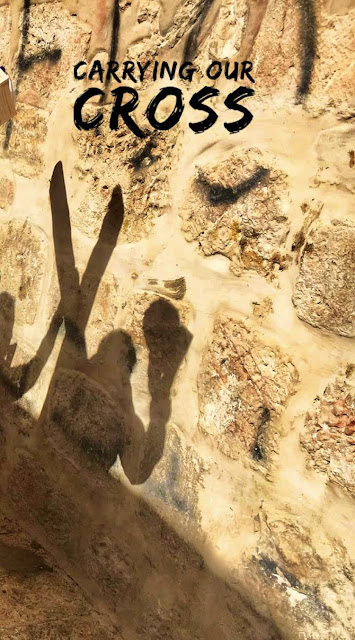(Part 2 of Day 8)
As I write this blog, I’m feeling a bit emotional. Thoughts that the
holy places we visited on our pilgrimage might be wiped out forever. Thoughts
that the people we met or just encountered there might be living in fear right
now. Sad thoughts. I know all things will pass as Jesus said in Matthew 24:35 –
“Heaven and earth will pass away, but my words will never pass away.” But I
just wish not in this violent way and not in my lifetime. I would love to visit
the Holy Land again.
Before these holy sites pass away, come visit
them with me as I continue to record the rest of the 8th day of our
pilgrimage. In my previous blog, I narrated our experience walking the Via
Dolorosa.
After tracing the Way of the Cross, we meandered through Souk el-Dabbagha, the Old City Bazaar outside the Church of the Holy Sepulcher. I wish we had more time to inspect the spices and food strange to my eyes and probably my palate. There were also souvenirs that escaped my wallet because we didn’t have time to shop as we were off to lunch.
 |
| Old City Bazaar |
After that we exited Jerusalem through the Jaffa Gate, one of the most picturesque gates dating back to the 16th century.
 |
| Wall of the Old City of Jerusalem with Jaffa Gate and the Tower of David |
Our afternoon was spent in Ein Kerem, the hill country where the Church of the Visitation sits on the site of Zechariah and Elizabeth’s summer house. It was a long and tiring climb up to the church even if the stairs weren’t steep. Our super senior co-pilgrims stayed in the garden at the bottom of the hill and just enjoyed an ice cream treat from our tour organizer, my cousin Belle.
 |
| Steps to the Church of the Visitation |
We got to see the upper church but only got a
peek at the lower church as there was a mass going on.
 |
| Altar & frescoes of the Upper Church |
In the Courtyard are ceramic plaques of Mary’s
Magnificat (Canticle of Praise) in 42 languages.
Going back downhill, we next visited the Church
of the Nativity of St. John the Baptist or St. John Ba Harim (St. John of the
Mountains). The church is also Catholic, this one built on the site of the
house in the valley where St. John was born.
- · Jewish custom dictates one should never turn one’s back to the Wall. People have to walk backwards as they exit.
- · In the Western Wall Plaza, there are fountains for ritual hand washing where you have to cleanse before entering.
- · Women have a separate section where they can pray.
We also took a tour of the Western Wall Tunnel where we saw the Master Course stone. It is the largest of the Herodian ashlars measuring 41 feet long x almost 12 feet high x 14 feet deep, weighing almost 600 tons. Also inside the tunnel is the Struthion Pool, a cistern built by Herod the Great, and a scale model of the Temple Mount.
 |
| Wailing Wall |
Although the Wailing Wall is not part of our
pilgrimage, it was still a site we wanted to view, to experience and understand
the Jewish side of Jesus.










.jpg)
